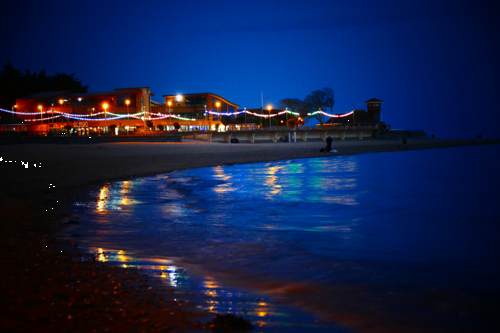Shining a Light on Coastal Light Pollution
The creation of artificial light has dramatically changed the natural environment. Light pollution from buildings, vehicles and streetlights has the potential to alter the behaviour of many animals. An iconic example involves the disorientation of hatchling turtles; normally guided to the sea by natural light, the baby turtles instead end up on beach promenades, hotel grounds, and busy roads. Now new research published in Journal of Animal Ecology has discovered that other, less well-known marine species are also affected – with the potential for dramatic consequences.

Approximately 22% of coastlines around the world experience artificial light at night, yet little research has been conducted on these intertidal ecosystems. To address this, a collaboration between the University of Exeter and the Plymouth Marine Laboratory conducted a series of experiments to determine whether a key intertidal species was affected by exposure to night-time lighting. The dogwhelk (Nucella lapillus) is a widespread predatory mollusc which plays a key role in ecological balance through predation upon barnacles, limpets and mussels. Dogwhelks are typically most active at night and are often found in close proximity to urban areas – a combination which could leave them susceptible to artificial light exposure. Lead author Ms Charlotte Underwood, a Masters student at the University of Exeter, kept two groups of dogwhelks in different conditions and studied their behaviour. The control group experienced simulated natural light conditions, whilst the other group were kept in conditions mimicking nocturnal light pollution. Dogwhelks in both groups were then exposed to olfactory cues from prey and predators.
The results showed that night-time lighting affected the basal and foraging activity of dogwhelks, regardless of predator presence. Dogwhelks exposed to light pollution spent more time foraging and less time seeking refuges than animals in the control group. Even when predator scent cues were present, the night-time light group continued to respond to prey. This behaviour might indicate an opportunistic approach by dogwhelks towards using vision instead of smell when light pollution is present. However, night-time lighting could also increase the visibility of dogwhelks to predators, counter-acting benefits from increased foraging.
This study shows, for the first time, that artificial night-time lighting influences the behaviour of intertidal fauna. The authors suggest that the effects of artificial night-time lighting on dogwhelk behaviour are comparable with those observed in response to ocean acidification and climate change. “Because we designed this study replicating experiments where we had measured the impacts of climate change, we have here the first evidence that night time lighting can impact marine wildlife in coastal communities to a similar degree and in a much more generalised way than we thought,” says Dr Ana Queirós, study co-author and senior ecologist at the Plymouth Marine Laboratory. Coastal light pollution may even have the potential to alter trophic interactions within rocky shore communities. Dr Queirós highlights that disturbance of such species interactions can have major ramifications. “Who eats whom and how, the species interactions we measured at the inner workings of food webs,” she says. “So it is not just nesting turtles and hatchlings on the beaches that are affected: it is the whole way in which shore food chains work.”
Such impacts of light pollution on coastal ecosystems has been overlooked in the past. “There has been a surge of research into the impacts of artificial lighting on land animals and plants of the last six years, but the influence on coastal animals of lights from harbours, marinas, piers and promenades has received very little attention,” says study co-author Dr Thomas Davies from the University of Exeter’s Environment and Sustainability Institute. “This study highlights that night-time lighting in coastal cities can impact biodiversity on rocky shores popular with beachgoers that enjoy the diversity of life they offer year round.”
Read the full paper free
Underwood, C. N., Davies, T. W. and Queirós, A. M. (2017), Artificial light at night alters trophic interactions of intertidal invertebrates. Journal of Animal Ecology doi:10.1111/1365-2656.12670
Sarah Marley
Journal of Animal Ecology Blog Editor
Like what we stand for?
Support our mission and help develop the next generation of ecologists by donating to the British Ecological Society.